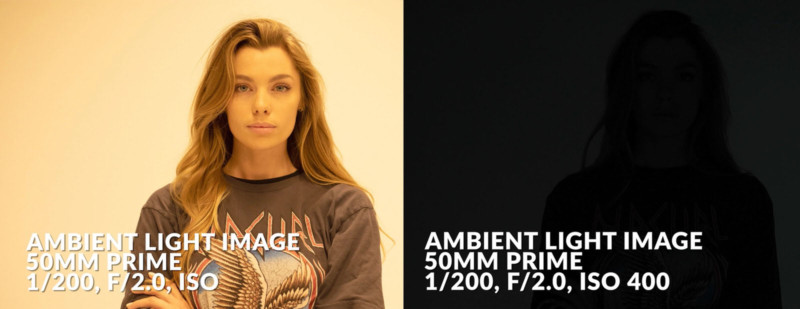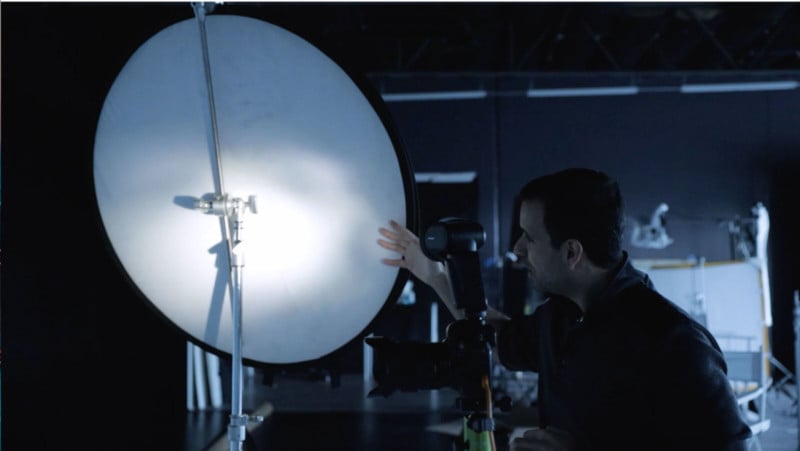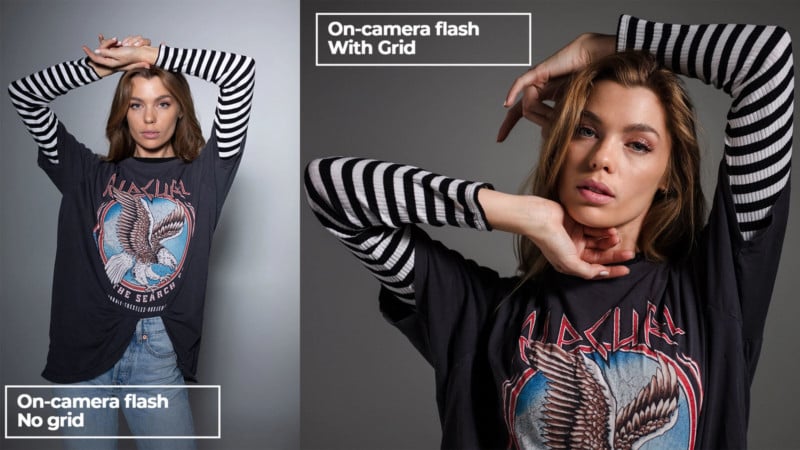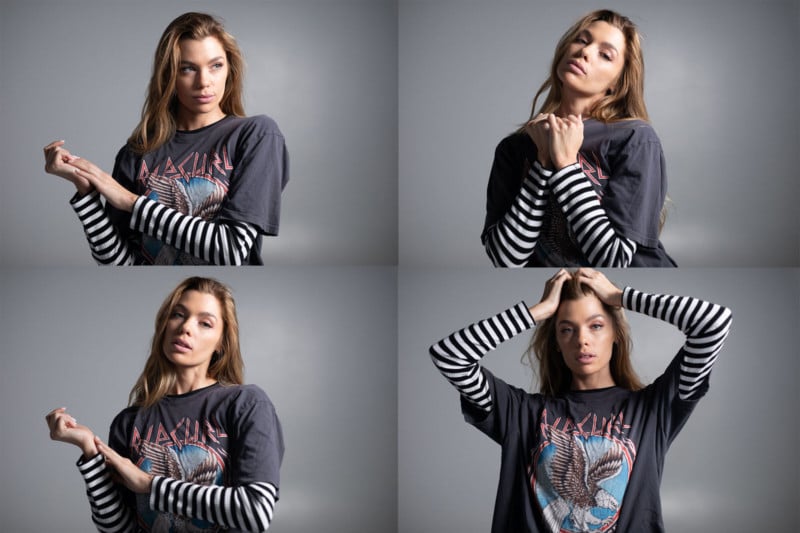Wondering how to make the most of the gear you have on hand? Here is a quick tutorial on how you can use your on-camera flash and a simple 5-in-1 reflector to create the look of an off-camera softbox.
Gear You’ll Need for This Technique
Now that we’ve discussed the gear we need, let’s discuss how we’re going to approach this technique. In the Lighting 3 course over at SLR Lounge, we created an easy acronym to try and conceptualize photos before pressing the shutter: C.A.M.P:
Composition: What do we want our scene to look like? Where do we want the camera to be? What’s the angle? What do we want our subjects to be doing?
Ambient Light Exposure: Choose the intention of the scene. Do we want a dramatic image (darkening the ambient light and using more flash) or do we want a softer image (brightening the ambient light and using a more natural power of flash)?
Modify/Add Light: Are your subjects visible in the frame or do they need to be chiseled out? Do you need to add an additional light source?
Pose and Photograph: Take your shot!
Let’s walk through each one of these steps to arrive at our final photograph:
1. Select Your Composition
I just wanted a standard shot of our model Devin so that I can focus more on the lighting technique so I opted for a center composed image, more of a half-body portrait to help draw focus to her face.
2. Dial-in Your Ambient Light Exposure

As you can see in the before shot, our ambient light is pretty nasty. I like to turn off any room lights that are causing mixed lighting. The main reason for this is because when you are bouncing an on-camera flash you don’t have a ton of power to begin with. B
y blocking out the ambient light, our on-camera flash is acting as our main light source. My final camera settings are 1/200th, f/2, and ISO 400. Your settings will vary depending on whether or not you are shooting indoors or outdoors.
3. Add and Modify On-Camera Flash

Place your reflector 45 degrees to your right or left, depending on where you want the light to come from.
Now comes the fun part. Point your on-camera flash in the direction of your reflector, making sure that it is firing directly into it. You’ll notice you are still losing a good chunk of light because it is spilling forward. This is when you’ll want to modify your on-camera flash with a grid.
Zooming in the flash won’t cut it because it doesn’t direct the light. Here is the difference of using the on-camera flash with a grid vs. without one:

4. Pose and Shoot Away!
And there you have it — with your light direction set up have your subject pose in a way that flatters the body. Here are some other shots I got with Devin after I set up my light:

We hope you enjoyed this tutorial!
P.S. To see more tutorials like this make sure you check out SLR Lounge Workshops for our full course library or check out our Flash Photography Training System, designed to help your master off-camera flash photography! This is an excerpt from a technique we teach in our Lighting 101 course and there are so many other lighting goodies and tricks jam-packed in there as well.
About the author: Pye Jirsa is a wedding photographer based in Southern California and the co-founder of SLR Lounge. The opinions expressed in this article are solely those of the author. You can find more of Jirsa’s work here. This article was also published here.
Continue reading...
Gear You’ll Need for This Technique
- On-Camera flash: For this tutorial, I am using the Profoto A1x
- Flash Grid
- 5-in-1 Reflector
- 40 in. Matthews C-Stand
Now that we’ve discussed the gear we need, let’s discuss how we’re going to approach this technique. In the Lighting 3 course over at SLR Lounge, we created an easy acronym to try and conceptualize photos before pressing the shutter: C.A.M.P:
Composition: What do we want our scene to look like? Where do we want the camera to be? What’s the angle? What do we want our subjects to be doing?
Ambient Light Exposure: Choose the intention of the scene. Do we want a dramatic image (darkening the ambient light and using more flash) or do we want a softer image (brightening the ambient light and using a more natural power of flash)?
Modify/Add Light: Are your subjects visible in the frame or do they need to be chiseled out? Do you need to add an additional light source?
Pose and Photograph: Take your shot!
Let’s walk through each one of these steps to arrive at our final photograph:
1. Select Your Composition
I just wanted a standard shot of our model Devin so that I can focus more on the lighting technique so I opted for a center composed image, more of a half-body portrait to help draw focus to her face.
2. Dial-in Your Ambient Light Exposure
As you can see in the before shot, our ambient light is pretty nasty. I like to turn off any room lights that are causing mixed lighting. The main reason for this is because when you are bouncing an on-camera flash you don’t have a ton of power to begin with. B
y blocking out the ambient light, our on-camera flash is acting as our main light source. My final camera settings are 1/200th, f/2, and ISO 400. Your settings will vary depending on whether or not you are shooting indoors or outdoors.
3. Add and Modify On-Camera Flash
Place your reflector 45 degrees to your right or left, depending on where you want the light to come from.
Now comes the fun part. Point your on-camera flash in the direction of your reflector, making sure that it is firing directly into it. You’ll notice you are still losing a good chunk of light because it is spilling forward. This is when you’ll want to modify your on-camera flash with a grid.
Zooming in the flash won’t cut it because it doesn’t direct the light. Here is the difference of using the on-camera flash with a grid vs. without one:
4. Pose and Shoot Away!
And there you have it — with your light direction set up have your subject pose in a way that flatters the body. Here are some other shots I got with Devin after I set up my light:
We hope you enjoyed this tutorial!
P.S. To see more tutorials like this make sure you check out SLR Lounge Workshops for our full course library or check out our Flash Photography Training System, designed to help your master off-camera flash photography! This is an excerpt from a technique we teach in our Lighting 101 course and there are so many other lighting goodies and tricks jam-packed in there as well.
About the author: Pye Jirsa is a wedding photographer based in Southern California and the co-founder of SLR Lounge. The opinions expressed in this article are solely those of the author. You can find more of Jirsa’s work here. This article was also published here.
Continue reading...


